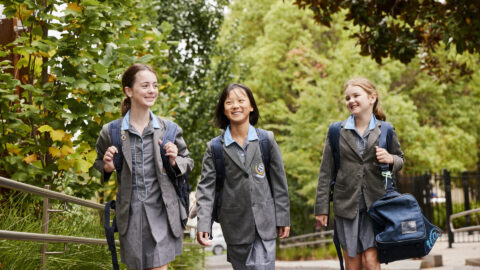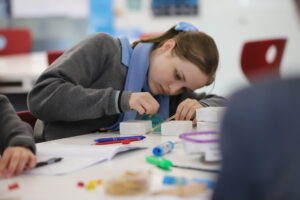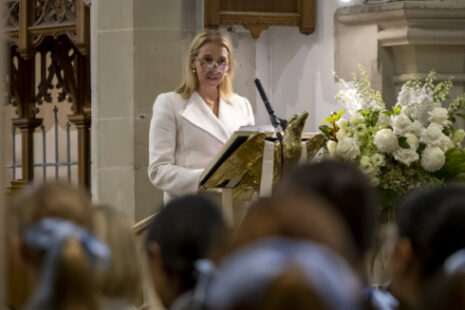Good. Great. Excellent. The Girls School Advantage

Good, great, excellent – the top 10 reasons why there is a distinct girls school advantage.
In my view, and by any metric you care to use, St Catherine’s is an excellent school.
Prior to joining St Catherine’s in 2017, I had spent a long career in co-educational schools. I have been fortunate to work in what many would consider two of the finest co-ed schools in Australia. While these two schools are indeed great, in my opinion, they don’t stack up to what girls-only schools achieve and certainly come nowhere close to the excellence of St Catherine’s.
Across the board girls schools outperform co-ed schools for educational outcomes for girls.
In Victoria, as of February 2023, according to ABS data there are:
- 1,566 Government Schools
- 499 Catholic Schools
- 225 Independent schools
This makes a grand total of 2,290 schools in the state. Of these, there are 44 independent secondary and combined all-girls schools.
Girls schools make up only 1.9% of all schools in Victoria.
However, when we look at 2023 VCE result rankings, using the measure of the percentage of Study Scores over 40, which is effectively the equivalent of an A+, out of the top 25 schools across Victoria, 13 are girls-only schools.
In other words, 52% of the top 25 schools are girls-only schools even though girls schools represent only 1.9% of schools in the state!
Investigating these results further, we see out of the top 10 schools in the rankings, seven are girls-only schools including St Catherine’s. That’s 70% of the top 10 schools are girls schools!
St Catherine’s VCE results sit comfortably inside the top 10 schools in the State and have done so for years.
Some academics argue socio-economic factors explain the variation in academic achievement. While there is some credence to that argument, the fact remains that girls schools, year in and year out, produce extraordinary academic results and St Catherine’s School continues to produce excellence across academic results, programs and educators.
Even though high VCE Study Scores and ATARs are not the be-all of education, they are still very important. Teaching and learning are our core roles at St Catherine’s and yes, we also value many other things in our conduct as a school, but doing well in the VCE is an absolute priority. Our talented and skilled team of teachers is committed to providing an education of the highest quality.
So, how is it that girls schools provide such high educational achievement?
The International Coalition of Girls’ Schools (ICGS) supports girls schools in Europe, the Americas, Africa, Asia, and Australasia, and conducts research into the benefits of single-sex education. One of their most recent pieces of research examined ‘The Positive Effects of the Girls’ School Environment: An Analysis of PISA Data’.* The ICGS findings trended overwhelmingly positive across several measures for those students attending girls schools, including:
- Classrooms at girls schools are less disruptive, and students see a clearer correlation between effort and future opportunities.
- Students at girls schools found greater satisfaction and enjoyment in working hard toward a goal, preferring to persist until mastered.
- Wellbeing was noted as a strength at girls schools, with fewer incidences of bullying.
Girls schools engage, challenge, inspire, and prepare girls for life beyond school. ICGS provides a Top 10 list of reasons to attend a girls school, all supported by research.
-
INSPIRATIONAL ENVIRONMENT
Girls schools champion the educational needs of girls
 Single-sex programs … create an institutional and classroom climate in which female students can express themselves freely and frequently and develop higher order thinking skills. — Dr. Rosemary C. Salomone, St. John’s University, Public Single-Sex Schools: What Oprah Knew.
Single-sex programs … create an institutional and classroom climate in which female students can express themselves freely and frequently and develop higher order thinking skills. — Dr. Rosemary C. Salomone, St. John’s University, Public Single-Sex Schools: What Oprah Knew.
A notable majority of girls school students indicated that they have strong learning goals; they are intent to learn as much as possible, to completely master the material, and to understand the content of their classes as thoroughly as possible. — The Positive Effects of the Girls’ School Environment: An Analysis of PISA Data, Macquarie Marketing Group study of the Organisation for Economic Co-operation and Development’s (OECD) Programme for International Student Assessment (PISA).
The robust learning environment encountered by students at all-girls schools is highlighted by a recent survey of high school students. The girls’ responses provide unequivocal support for the value of an all-girls educational environment. — Dr. Richard A. Holmgren, Steeped in Learning: The Student Experience at All-Girls Schools.
-
ACADEMIC ACHIEVEMENT
Girls schools create a culture of achievement
More than 80 percent of girls school graduates consider their academic performance to be highly successful. — Dr. Linda Sax, UCLA, Women Graduates of Single-Sex and Coeducational High Schools: Differences in their Characteristics and the Transition to College.
Nearly 80 percent of girls school students report that most of their classes challenge them to achieve their full academic potential, compared to 72 percent of girls at co-ed independent and 44 percent at co-ed public schools. — Dr. Richard A. Holmgren, Allegheny College, Steeped in Learning: The Student Experience at All-Girls Schools.
-
BUILDING SELF-CONFIDENCE
At girls schools, girls occupy every role
 Seventy-seven percent of girls school students reported having self-confidence. They noted feeling a sense of accomplishment, identifying that when they are in a difficult situation, they can usually find a way out of it, and that they can handle many things at a time. — The Positive Effects of the Girls’ School Environment: An Analysis of PISA Data, Macquarie Marketing Group study of the Organisation for Economic Co-operation and Development’s (OECD) Programme for International Student Assessment (PISA).
Seventy-seven percent of girls school students reported having self-confidence. They noted feeling a sense of accomplishment, identifying that when they are in a difficult situation, they can usually find a way out of it, and that they can handle many things at a time. — The Positive Effects of the Girls’ School Environment: An Analysis of PISA Data, Macquarie Marketing Group study of the Organisation for Economic Co-operation and Development’s (OECD) Programme for International Student Assessment (PISA).
A majority of girls school graduates report higher self-confidence than their co-ed peers. — Dr. Linda Sax, UCLA, Women Graduates of Single-Sex and Coeducational High Schools: Differences in their Characteristics and the Transition to College.
All-girls settings seem to provide girls a certain comfort level that helps them develop greater self-confidence and broader interests, especially as they approach adolescence. — Dr. Rosemary C. Salomone, St. John’s University, Same, Difference, Equal: Rethinking Single-Sex Schooling.
-
DEVELOPING LEADERSHIP SKILLS
Girls schools empower students to become bold leaders
Programs at girls schools focus on the development of teamwork over other qualities of leadership, while the qualities of confidence, compassion, and resilience also ranked prominently. — Dr. Nicole Archard, Kincoppal-Rose Bay School of the Sacred Heart, Student Leadership Development in Australian and New Zealand Secondary Girls’ Schools: A Staff Perspective.
93 percent of girls school graduates say they were offered greater leadership opportunities than their peers at co-ed schools, and 80 percent have held leadership positions since graduating from high school. — Goodman Research Group, The Girls’ School Experience: A Survey of Young Alumnae of Single-Sex Schools.
-
FOCUS ON SCIENCE, TECHNOLOGY, ENGINEERING & MATH (STEM)
Girls schools champion the educational needs of girls as a group that is underrepresented in STEM majors and careers
 Girls school grads are six times more likely to consider majoring in math, science, and technology, compared to girls who attend co-ed schools. — Goodman Research Group, The Girls’ School Experience: A Survey of Young Alumnae of Single-Sex Schools.
Girls school grads are six times more likely to consider majoring in math, science, and technology, compared to girls who attend co-ed schools. — Goodman Research Group, The Girls’ School Experience: A Survey of Young Alumnae of Single-Sex Schools.
Compared to their co-ed peers, girls school graduates are three times more likely to consider engineering careers. — Dr. Linda Sax, UCLA, Women Graduates of Single-Sex and Coeducational High Schools: Differences in their Characteristics and the Transition to College.
During the middle school years, girls show a decline in both their performance in mathematics, and in their attitudes toward mathematics. Research suggests that girls schools may mitigate that decline, in comparison with co-ed schools. — Dr. Carlo Cerruti, Harvard University, Exploring Girls’ Attitudes About Math.
-
DEDICATION TO HOW GIRLS LEARN
Girls schools know how girls learn best
To be successful, students need more than just a feeling of support. That support must translate into actions that are geared toward student success. Nearly 96 percent of girls school students report receiving more frequent feedback on their assignments and other course work, compared to 93 percent of girls at co-ed independent schools, and 80 percent at co-ed public schools. — Dr. Richard A. Holmgren, Allegheny College, Steeped in Learning: The Student Experience at All-Girls Schools.
A study prepared for the U.S. Department of Education demonstrated more positive academic and behavioural interactions between teachers and students in the single-sex schools than in the comparison to co-ed schools. — U.S. Department of Education, Early Implementation of Public Single-Sex Schools: Perceptions and Characteristics.
Teachers at girls schools employ alternative teaching strategies and lesson plans to maximise the learning of their students. — The Positive Effects of the Girls’ School Environment: An Analysis of PISA Data, Macquarie Marketing Group study of the Organisation for Economic Co-operation and Development’s (OECD) Programme for International Student Assessment (PISA).
-
NURTURING HIGHER ASPIRATIONS
Girls school students strive for greatness
Girls at all levels of achievement in the single-sex schools receive a … benefit from the single-sex school environment in terms of heightened career aspirations—an effect unprecedented in any other portion of our study. — Dr. Cary M. Watson, Stanford University, Sex Roles: A Journal of Research.
Students at girls schools have higher aspirations and greater motivation than their female peers at co-ed independent and public schools, and more than 2/3 expect to earn a graduate or professional degree. — Dr. Richard A. Holmgren, Allegheny College, Steeped in Learning: The Student Experience at All-Girls Schools.
-
PROVIDING EXCELLENT MENTORING
Girls school students are mentored by a community of peers, teachers, and school administrators
 Overall, female students at girls schools noted more frequently than their co-ed peers that their teachers were enthusiastic, displaying higher levels of teacher encouragement and motivation. — The Positive Effects of the Girls’ School Environment: An Analysis of PISA Data, Macquarie Marketing Group study of the Organisation for Economic Co-operation and Development’s (OECD) Programme for International Student Assessment (PISA).
Overall, female students at girls schools noted more frequently than their co-ed peers that their teachers were enthusiastic, displaying higher levels of teacher encouragement and motivation. — The Positive Effects of the Girls’ School Environment: An Analysis of PISA Data, Macquarie Marketing Group study of the Organisation for Economic Co-operation and Development’s (OECD) Programme for International Student Assessment (PISA).
The overwhelming majority of girls school students agree, to strongly agree, that they feel supported at their schools: 95 percent said they feel supported by their teachers, compared to 84 percent of girls at co-ed schools; 90 percent report feeling supported by other students compared to 73 percent of girls at co-ed schools, and 83 percent feel supported by their school administrators, compared to 63 percent of girls at co-ed schools. — Dr. Richard A. Holmgren, Allegheny College, Steeped in Learning: The Student Experience at All-Girls Schools.
Research indicates that girls place more emphasis on interpersonal relationships than boys do, which may provide girls with beneficial social support … Compared to boys, girls are more likely to socialize in smaller groups, share more personal information with each other, and emphasize helping behaviour over competitive behavior in their friendships. — Dr. Lisa Damour, Center for Research on Girls at Laurel School, Girls and Their Peers.
-
PREPARING GIRLS FOR THE REAL WORLD
Girls schools engage students in activities that prepare them for life beyond the classroom
Nearly half of all women graduating from single-sex schools rate their public speaking ability as “high,” compared to 39 percent of women graduates from co-ed schools. A similar differential exists for writing abilities: 64 percent of girls school graduates assess their writing skills as “high,” compared to 59 percent of women graduates of co-ed schools. — Dr. Linda Sax, UCLA, Women Graduates of Single-Sex and Coeducational High Schools: Differences in their Characteristics and the Transition to College.
In the world outside of school, the answers are not always found in the text. Girls schools prepare students for the world beyond school by requiring outside research, encouraging them to connect ideas across problem domains, and challenging them to grapple with problems with no clear solution. —Dr. Richard A. Holmgren, Allegheny College, Steeped in Learning: The Student Experience at All-Girls Schools.
-
ALLOWING GIRLS TO BE THEMSELVES
Girls schools provide an environment where students feel safe to express themselves and engage in an open and safe exchange of ideas
 More than 88 percent of girls school students report that they are comfortable being themselves at school, which means that they are free to focus their energies on their learning. — Dr. Richard A. Holmgren, Allegheny College, Steeped in Learning: The Student Experience at All-Girls Schools.
More than 88 percent of girls school students report that they are comfortable being themselves at school, which means that they are free to focus their energies on their learning. — Dr. Richard A. Holmgren, Allegheny College, Steeped in Learning: The Student Experience at All-Girls Schools.
Students at girls schools indicated more frequently than girls at co-ed schools that they made friends easily, felt like they belonged, and that other students seemed to like them. — The Positive Effects of the Girls’ School Environment: An Analysis of PISA Data, Macquarie Marketing Group study of the Organisation for Economic Co-operation and Development’s (OECD) Programme for International Student Assessment (PISA).
93 percent of girls school graduates are “Very” or “Extremely Satisfied” with their school’s ability to provide individualized attention, and 80 percent strongly feel encouragement to develop their own interests. — Goodman Research Group, The Girls’ School Experience: A Survey of Young Alumnae of Single-Sex Schools.
Whether our girls at St Catherine’s want to be an astronaut, ambassador, or accountant, a girl needs to know—not just think, but really know, deep down —that nothing can stand in her way. Girls schools and especially St Catherine’s, ignite, nurture and extend this belief for all our girls, every day.
To discover more about St Catherine’s School’s excellence in championing girls book a Principal’s Tour here.






